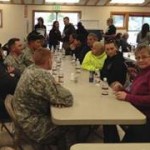EVERETT, Wash. – Girls who lost friends in the SR 530 slide sang out their feelings in a song they wrote with the help of Grammy-winning musician Star Nayea and Sauk-Suiattle elder Mary Jack, enrolled at Tulalip.
The girls represented the Sauk-Suiattle Indian Tribe, Tulalip tribes and the town of Darrington at a community meeting in Darrington on April 3 – by singing their song “Oso Strong, Highway 530.”
“This song is from the girls’ hearts. They lost friends in the slide. It’s been a difficult time,” elder Jack said. “Oso Strong Highway 530” has helped the girls in so many ways. Maybe the song will help the community start to heal, too.”
The lyrics express sadness, ask “why?” and promise to never forget any of communities along SR 530 –from Arlington to Darrington – while calling these communities together, to rise up, to be strong.
Personal traumatic experiences have given Nayea special understanding of the healing power of song.
“When you’re faced with tragedy that’s only 20 miles down the road from you, it’s unfathomable,” Nayea said. “There are no words to describe or capture the feeling it brings sharing this gift of healing power of music. It is a priceless gift and privilege, and honor of having an opportunity to make a difference in someone’s life.”
Oso Strong Highway 530
Composed and performed by: Kaylee Frazee, Sarah Larson, Jordan Maltos, Malia Maltos, Raime McCord, Kyla Roundface, Natalie Stewart.
Produced and arranged by: Star Nayea
When life gets to be, too much.
When I fall away and lose touch…
There’s always a reason, a lesson to be learned
We ask the question why…
To know the answers may make us cry.
Can there be any good, to replace this pain.
Does the Creator have the master plan, to this game?
Oso strong, Darrington, Hazel too
Oso life, you and I, we’ll make it through
From the outside looking in,
You could never understand.
We all came together,
To lend a helping hand.
No picture will compare
Can’t imagine, how, or where…
So over whelming, how we feel inside
No words can explain, no answers why?
Oso strong Arlington, Skaglund Hill.
Oso life, Steelhead Drive we won’t forget you!
Oso bright, is the light…
We search to find!
Threads of our community are frayed.
We all must rise up, to pray!
Painful memories… may never fade.
Life will go on, starting today!
Oso Strong, Darrington, Sauk-Suiattle, too
Oso life, you and I, we’ll make it through.
Oso strong, Arlington, Skaglund Hill;
Oso life, Steelhead Drive, we won’t forget you.
Oso special, are the ones, left behind.
Oso bright, is the light, we search to find!
©Copyright 2014, all rights reserved. Sauk-Suiattle Indian Tribe, Darrington Wash.
As recovery continues, help is still available.
To see information and links to multiagency resources on the Snohomish County website, click: SnohomishCountywa.gov/2354/530-Slide.
Those directly impacted by the SR 530 Slide may call a help line operated by the state of Washington. The number is (800) 688-3469. Hours of operation for the help line are Monday through Friday, 8 a.m. to 5 p.m., Pacific Daylight Time. For more information, click: www.emd.wa.gov.
SR 530 Slide survivor can also continue to speak directly with FEMA representatives by calling the FEMA help line. The number is (800) 621-FEMA (3362). 711 or Video Relay Service (VRS) is available through this number. Survivors who use TTY, may call (800) 462-7585. The toll-free telephone numbers will operate from 4 a.m. to 7 p.m. Pacific Daylight Time, seven days a week. For more FEMA information, click: www.fema.gov/disaster/4168.












